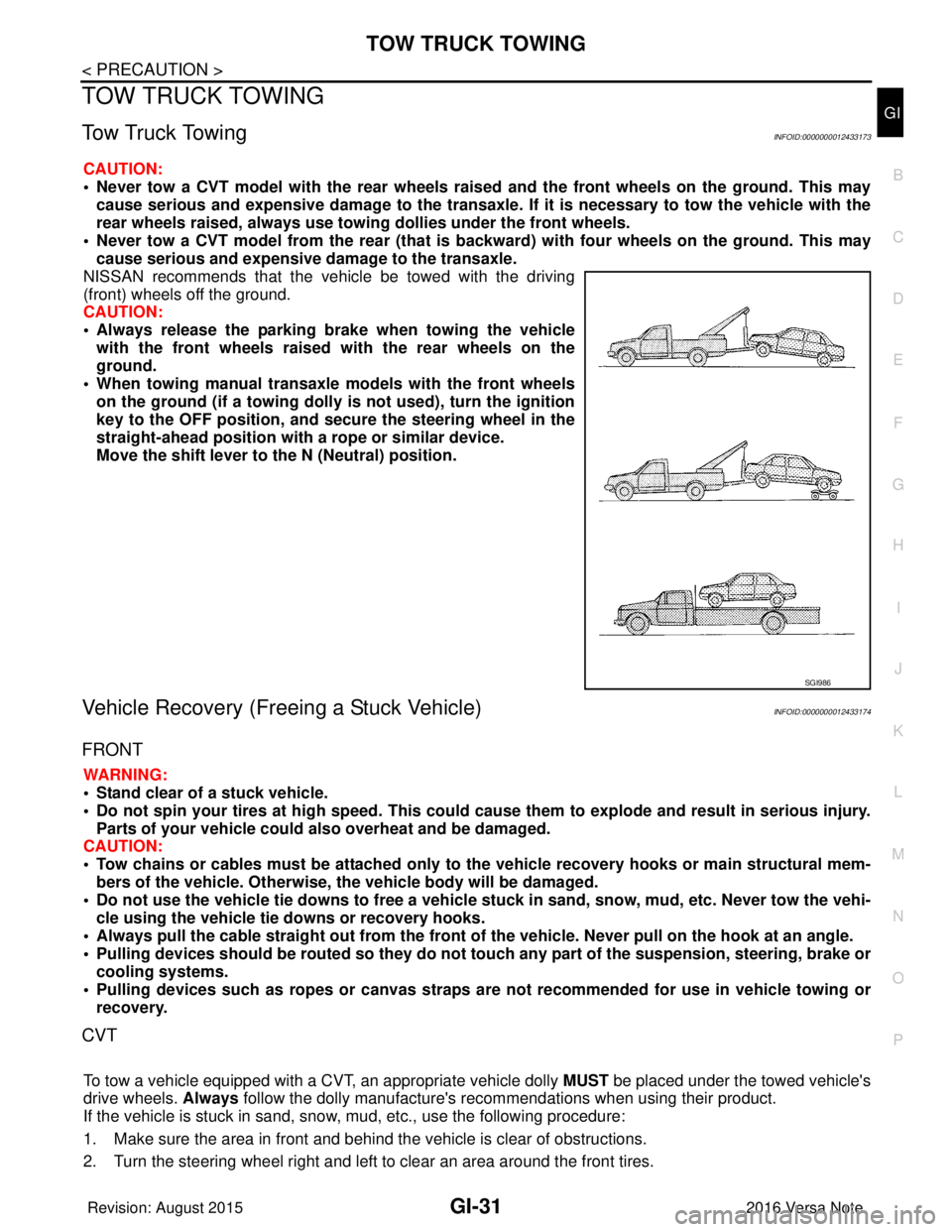2016 NISSAN NOTE four wheel drive
[x] Cancel search: four wheel drivePage 142 of 3641
![NISSAN NOTE 2016 Service Repair Manual AV
SYSTEMAV-137
< SYSTEM DESCRIPTION > [NAVIGATION]
C
D
E
F
G H
I
J
K L
M B A
O P
• In map-matching, alternative routes to reach the destination will be shown and prioritized, after the road on whic NISSAN NOTE 2016 Service Repair Manual AV
SYSTEMAV-137
< SYSTEM DESCRIPTION > [NAVIGATION]
C
D
E
F
G H
I
J
K L
M B A
O P
• In map-matching, alternative routes to reach the destination will be shown and prioritized, after the road on whic](/manual-img/5/57363/w960_57363-141.png)
AV
SYSTEMAV-137
< SYSTEM DESCRIPTION > [NAVIGATION]
C
D
E
F
G H
I
J
K L
M B A
O P
• In map-matching, alternative routes to reach the destination will be shown and prioritized, after the road on which the vehicle is cur-
rently driven has been judged and the vehicle mark has been repo-
sitioned.
Alternative routes will be shown in different order of priority, and
the incorrect road can be avoided if there is an error in distance
and/or direction.
Routes are of the same priority if two roads are running in parallel.
Therefore, the vehicle mark may appear on either of them alter-
nately, depending on maneuvering of the steering wheel and con-
figuration of the road.
• Map-matching does not function correctly when a road on which the vehicle is driving is new and not recorded in the map SD-card,
or when road pattern stored in the map data and the actual road
pattern are different due to repair.
The map-matching function may find another road and position the
vehicle mark on it when driving on a road not present in the map.
Then, the vehicle mark may change to it when the correct road is
detected.
• Effective range for comparing the vehicle position and travel direc-
tion calculated by the distance and direction with the road data
read from the map SD-card is limited. Therefore, correction by
map-matching is not possible when there is an excessive gap
between current vehicle position and the position on the map.
GPS (Global Posi tioning System)
GPS (Global Positioning System) is developed for and is controlled
by the US Department of Defense. The system utilizes GPS satel-
lites (NAVSTAR), transmitting out radio waves while flying on an orbit
around the earth at an altitude of approximately 21,000 km (13,049
mile).
The receiver calculates the travel position in three dimensions (lati-
tude/longitude/altitude) according to the time lag of the radio waves
that four or more GPS satellites transmit (three-dimensional position-
ing). The GPS receiver calculates the travel position in two dimen-
sions (latitude/longitude) with the previous altitude data if the GPS
receiver receives only three radio waves (two-dimensional position-
ing). GPS position correction is not performed while stopping the
vehicle.
Accuracy of the GPS will deteriorate under the following conditions:
• In two-dimensional positioning, GPS accuracy will deteriorate when altitude of the vehicle position changes.
• The position of GPS satellite affects GPS detection pr ecision. The position detection may not be precisely
performed.
• The position detection is not performed if GPS receiver does not receive radio waves from GPS satellites. (Inside a tunnel, parking in a building, under an elevated highway etc.) GPS receiver may not receive radio
waves from GPS satellites if any object is placed on the GPS antenna.
NOTE:
• The detection result has an error of approximately 10 m (32.81 ft) even with a high-precision three dimen-
sional positioning.
• There may be cases when the accuracy is lowered and radio waves are stopped intentionally because the GPS satellite signal is controlled by the US trace control center.
USB INTERFACE AND AUX IN JACK
•iPod® or music files in USB memory can be played.
• Sound signals are transmitted from USB interface to the AV control unit and output to each speaker.
•iPod
® is recharged when connected to USB interface.
• Sound can be output from an external device by connecting a device to the AUX in jack.
• AUX sound signals are transmitted to each speaker via AV control unit.
SEL686V
SKIA0613E
SEL526V
Revision: August 2015 2016 Versa Note
cardiagn.com
Page 471 of 3641
![NISSAN NOTE 2016 Service Repair Manual SYSTEMBRC-23
< SYSTEM DESCRIPTION > [VDC/TCS/ABS]
C
D
E
G H
I
J
K L
M A
B
BRC
N
O P
• Brake force control function at braking hard detects driver ′s brake operations with the pressure sensor,
judg NISSAN NOTE 2016 Service Repair Manual SYSTEMBRC-23
< SYSTEM DESCRIPTION > [VDC/TCS/ABS]
C
D
E
G H
I
J
K L
M A
B
BRC
N
O P
• Brake force control function at braking hard detects driver ′s brake operations with the pressure sensor,
judg](/manual-img/5/57363/w960_57363-470.png)
SYSTEMBRC-23
< SYSTEM DESCRIPTION > [VDC/TCS/ABS]
C
D
E
G H
I
J
K L
M A
B
BRC
N
O P
• Brake force control function at braking hard detects driver ′s brake operations with the pressure sensor,
judges a brake booster ′s maximum brake power function by using information from the vacuum sensor, and
enhances more powerful braking force by controlling brakes of four wheels.
• VDC warning lamp blinks while VDC function is in operat ion and indicates to the driver that the function is in
operation.
• CONSULT can be used to diagnose the system.
• Fail-safe function is adopted. When a malfunction occurs in VDC function, the control is suspended for VDC
function and TCS function. However, ABS function and EBD function operate normally. Refer to BRC-39,
"Fail-safe".
INPUT SIGNAL AND OUTPUT SIGNAL
Major signal transmission between each unit via communication lines is shown in the following table.
OPERATION CHARACTERISTICS
VDC Function That Prevents Oversteer Tendency
• During cornering, brake force (brake fluid pressure) is applied on front wheel and rear wheel on the outer
side of turn. Momentum is generated directing the vehicle toward the outer side of the turn. Oversteer is pre-
vented.
• Changing driving lane on a slippery road, when there may be a tendency to oversteer, engine output is con-
trolled as well as brake force (brake fluid pr essure) of 4 wheels. Oversteer tendency decreases.
Component Signal description
ECM Transmits the following signals to ABS actuator an
d electric unit (control unit) via CAN commu-
nication:
• Acceleration pedal position signal
• Engine speed signal
• Target throttle position signal
TCM Transmits the current gear positi
on signal to ABS actuator and electric unit (control unit) via
CAN communication.
Steering angle sensor Transmits the steering an
gle sensor signal to ABS actuator an d electric unit (control unit) via
CAN communication.
Combination meter Transmits the following signals to ABS actuator an
d electric unit (control unit) via CAN commu-
nication:
• Brake fluid level switch signal
• parking brake switch signal
Receives the following signals from ABS actuator and electric unit (control unit) via CAN com-
munication:
• VDC OFF indicator lamp signal
• SLIP indicator lamp signal
ALFIA0339GB
ALFIA0340GB
Revision: August 2015 2016 Versa Note
cardiagn.com
Page 1902 of 3641

GI-14
< HOW TO USE THIS MANUAL >
ABBREVIATIONS
ABBREVIATIONS
Abbreviation ListINFOID:0000000012433154
The following ABBREVIATIONS are used:
A
B
C
D
ABBREVIATION DESCRIPTION
A/C Air conditioner
A/C Air conditioning
A/F sensor Air fuel ratio sensor A/T Automatic transaxle/transmission
ABS Anti-lock braking system
ACCS Advance climate control system ACL Air cleaner
AP Accelerator pedal
APP Accelerator pedal position
ATF Automatic transmission fluid
AV Audio visual
AVM Around view monitor
AWD All wheel drive
ABBREVIATION DESCRIPTION
BARO Barometric pressure BCI Backup collision intervention
BCM Body control module
BLSD Brake limited slip differential
BPP Brake pedal position
BSI Blind spot intervention
BSW Blind spot warning
ABBREVIATION DESCRIPTION
CKP Crankshaft position
CL Closed loop
CMP Camshaft position
CPP Clutch pedal position
CTP Closed throttle position
CVT Continuously variable transaxle/transmission
ABBREVIATION DESCRIPTION
D
1Drive range first gear
D
2Drive range second gear
D
3Drive range third gear
D
4Drive range fourth gear
DCA Distance control assist
DDS Downhill drive support
DFI Direct fuel injection system
Revision: August 2015 2016 Versa Note
cardiagn.com
Page 1906 of 3641

GI-18
< HOW TO USE THIS MANUAL >
ABBREVIATIONS
U
V
W
1
2
3
4
5
6
7
ABBREVIATIONDESCRIPTION
USS Uphill start support
ABBREVIATION DESCRIPTION
VCM Vehicle control module
VDC Vehicle dynamics control system
VIN Vehicle identification number
VSS Vehicle speed sensor
ABBREVIATION DESCRIPTION
WOT Wide open throttle
ABBREVIATION DESCRIPTION
1
11st range first gear
1
21st range second gear
1GR First gear
ABBREVIATION DESCRIPTION
2
12nd range first gear
2
22nd range second gear
2GR Second gear
2WD 2-wheel drive
ABBREVIATION DESCRIPTION
3GR Third gear
ABBREVIATION DESCRIPTION
4GR Fourth gear
4WAS Four wheel active steer 4WD Four wheel drive
ABBREVIATION DESCRIPTION
5GR Fifth gear
ABBREVIATION DESCRIPTION
6GR Sixth gear
ABBREVIATION DESCRIPTION
7GR Seventh gear
Revision: August 2015 2016 Versa Note
cardiagn.com
Page 1919 of 3641

TOW TRUCK TOWINGGI-31
< PRECAUTION >
C
DE
F
G H
I
J
K L
M B
GI
N
O PTOW TRUCK TOWING
To w T r u c k To w i n gINFOID:0000000012433173
CAUTION:
• Never tow a CVT model with the rear wheels raised and the front wheels on the ground. This may
cause serious and expensive damage to the transaxle. If it is necessary to tow the vehicle with the
rear wheels raised, always use towin g dollies under the front wheels.
• Never tow a CVT model from the rear (that is b ackward) with four wheels on the ground. This may
cause serious and expensive damage to the transaxle.
NISSAN recommends that the vehicle be towed with the driving
(front) wheels off the ground.
CAUTION:
• Always release the parking br ake when towing the vehicle
with the front wheels raised with the rear wheels on the
ground.
• When towing manual transaxle models with the front wheels on the ground (if a towing dolly is not used), turn the ignition
key to the OFF position, and secu re the steering wheel in the
straight-ahead position with a rope or similar device.
Move the shift lever to th e N (Neutral) position.
Vehicle Recovery (Freeing a Stuck Vehicle)INFOID:0000000012433174
FRONT
WARNING:
• Stand clear of a stuck vehicle.
• Do not spin your tires at high speed. This could cause them to explode and result in serious injury.
Parts of your vehicle could also overheat and be damaged.
CAUTION:
• Tow chains or cables must be attached only to the vehicle recovery hooks or main structural mem-
bers of the vehicle. Otherwise, the vehicle body will be damaged.
• Do not use the vehicle tie downs to free a vehicle stuck in sand, snow, mud, etc. Never tow the vehi-
cle using the vehicle tie downs or recovery hooks.
• Always pull the cable straight out from the front of the vehicle. Never pull on the hook at an angle.
• Pulling devices should be routed so they do not touch any part of the suspension, steering, brake or
cooling systems.
• Pulling devices such as ropes or canvas straps ar e not recommended for use in vehicle towing or
recovery.
CVT
To tow a vehicle equipped with a CVT, an appropriate vehicle dolly MUST be placed under the towed vehicle's
drive wheels. Always follow the dolly manufacture's re commendations when using their product.
If the vehicle is stuck in sand, snow , mud, etc., use the following procedure:
1. Make sure the area in front and behind the vehicle is clear of obstructions.
2. Turn the steering wheel right and left to clear an area around the front tires.
SGI986
Revision: August 2015 2016 Versa Note
cardiagn.com